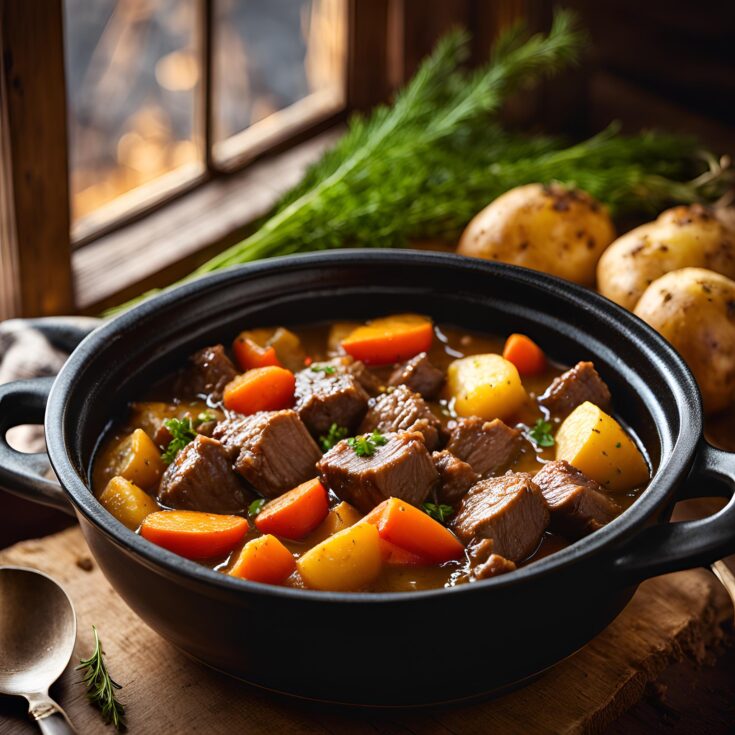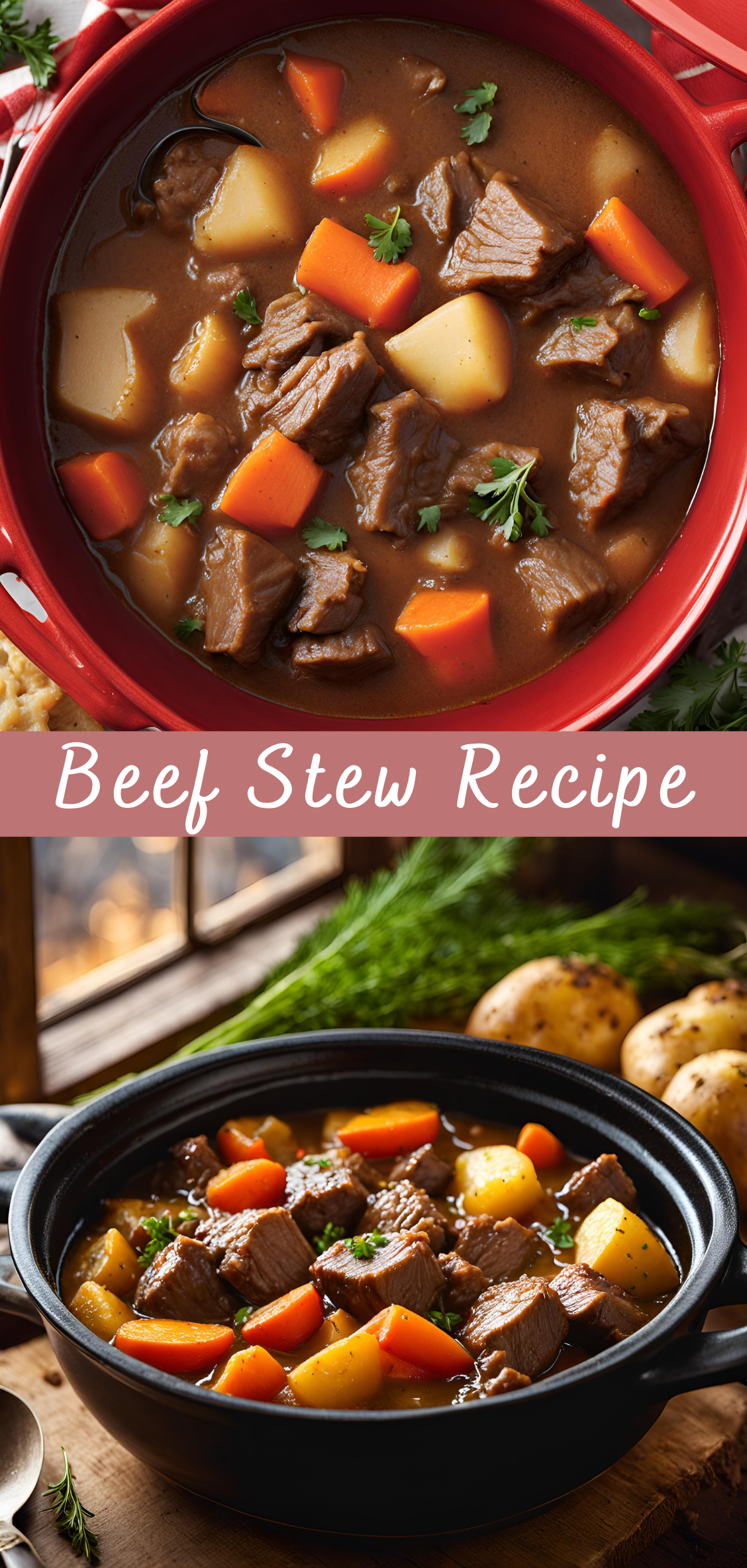Beef Stew Recipe
Beef stew is the epitome of comfort food—a hearty, soul-warming dish perfect for chilly nights, family gatherings, or a lazy weekend dinner. With tender beef, a medley of vegetables, and a rich, flavorful broth, this classic recipe is a favorite worldwide. In this guide, you’ll learn how to create a perfect beef stew that’s both simple and satisfying.

Why This Recipe Stands Out
- Unmatched Depth of Flavor: A combination of fresh herbs, slow cooking, and perfectly seared beef results in an irresistible dish.
- Nutrient-Packed: Loaded with vegetables and protein, it’s both delicious and nutritious.
- Easy to Adapt: Whether you prefer it with potatoes, rice, or crusty bread, this recipe is endlessly versatile.
- Meal Prep Friendly: Beef stew tastes even better the next day, making it ideal for leftovers or make-ahead meals.
Step-by-Step Instructions
Step 1: Prepare the Beef
- Pat Dry: Use paper towels to pat the beef cubes dry—this ensures a good sear.
- Season and Coat: Toss the beef with flour, salt, and pepper in a mixing bowl, coating each piece evenly.
Step 2: Sear the Beef
- Heat the Pot: Heat olive oil in a Dutch oven over medium-high heat.
- Sear in Batches: Add the beef cubes in a single layer, ensuring not to overcrowd the pot. Sear for 3–4 minutes per side until browned. Remove the beef and set aside. Repeat with remaining batches.
Step 3: Build the Flavor Base
- Sauté Aromatics: In the same pot, add diced onions and a pinch of salt. Sauté for 5 minutes until softened.
- Add Garlic and Tomato Paste: Stir in minced garlic and tomato paste, cooking for 2 minutes to enhance the flavors.
Step 4: Deglaze the Pot
- Pour in the Wine: Add red wine, scraping the bottom of the pot to release browned bits (this is where the flavor is!).
- Simmer: Let the wine reduce by half, about 3–5 minutes.
Step 5: Combine Ingredients
- Return the Beef: Add the seared beef back to the pot.
- Add Broth and Seasonings: Pour in the beef broth, Worcestershire sauce, balsamic vinegar, bay leaves, thyme, rosemary, and smoked paprika. Stir to combine.
Step 6: Simmer Low and Slow
- Bring to a Boil: Increase the heat and bring the stew to a gentle boil.
- Reduce and Cover: Lower the heat to a simmer, cover the pot, and let it cook for 1 hour. Stir occasionally to prevent sticking.
Step 7: Add Vegetables
- Layer Veggies: Add carrots, potatoes, celery, and mushrooms to the pot.
- Simmer Again: Cover and continue cooking for another 45 minutes, or until the vegetables are tender and the beef is melt-in-your-mouth soft.
Step 8: Finishing Touches
- Stir in Peas: Add the frozen peas during the last 5 minutes of cooking.
- Adjust Seasoning: Taste the stew and adjust with salt, pepper, or additional Worcestershire sauce as needed.
Tips for Success
- Choose the Right Beef: Beef chuck roast is ideal for stews due to its marbling, which breaks down beautifully when slow-cooked.
- Don’t Rush the Sear: Properly searing the beef creates a flavorful crust that enhances the entire dish.
- Low and Slow Cooking: Patience is key. The longer the stew simmers, the more tender the beef and flavorful the broth.
- Use Fresh Herbs: If available, substitute dried thyme and rosemary with fresh for a more vibrant flavor.
Variations
- Gluten-Free Option: Use cornstarch or a gluten-free flour blend to coat the beef.
- Low-Carb Version: Replace potatoes with cauliflower or parsnips.
- Vegetarian Stew: Swap the beef for hearty mushrooms or plant-based meat alternatives and use vegetable broth.
- Spicy Twist: Add a pinch of cayenne pepper or red chili flakes for a subtle kick.
Serving Suggestions
- Pair with crusty bread or buttered rolls for dipping.
- Serve over mashed potatoes or rice for an extra hearty meal.
- Top with fresh parsley for a pop of color and freshness.
Reheating
- Stovetop: Heat gently over low heat, adding a splash of water or broth if needed.
- Microwave: Heat in a microwave-safe bowl, stirring every minute to ensure even warming.
Frequently Asked Questions
Can I Make This in a Slow Cooker?
Absolutely! After searing the beef and preparing the aromatics, transfer everything to a slow cooker. Cook on low for 7–8 hours or high for 4–5 hours. Add the peas during the last 30 minutes.
Can I Skip the Red Wine?
Yes! Substitute with extra beef broth or use grape juice for a non-alcoholic option.
Why Is My Stew Watery?
If the stew is too thin, remove the lid during the last 15–20 minutes of cooking to let it reduce. Alternatively, thicken with a slurry of cornstarch and water.
The Secret to Perfect Beef Stew
The magic of beef stew lies in its ability to transform simple ingredients into a deeply satisfying dish. By focusing on proper searing, layering flavors, and slow cooking, you’ll create a stew that feels like a warm hug on a cold day.
Serve this beef stew with your favorite side dish or enjoy it as-is. Either way, it’s a recipe you’ll come back to time and again. Happy cooking!
Beef Stew Recipe

Beef stew is the epitome of comfort food—a hearty, soul-warming dish perfect for chilly nights, family gatherings, or a lazy weekend dinner. With tender beef, a medley of vegetables, and a rich, flavorful broth, this classic recipe is a favorite worldwide. In this guide, you’ll learn how to create a perfect beef stew that’s both simple and satisfying.
Ingredients
- 2 lbs beef chuck (cut into 1½-inch cubes)
- 2 tablespoons olive oil
- 1/4 cup all-purpose flour (for coating)
- 1 teaspoon salt
- 1/2 teaspoon black pepper
- 1 large onion (chopped)
- 3 garlic cloves (minced)
- 2 tablespoons tomato paste
- 1 cup red wine (optional, or substitute with beef broth)
- 4 cups beef broth
- 1 cup water
- 3 large carrots (peeled and cut into chunks)
- 3 large potatoes (peeled and cubed)
- 2 celery stalks (sliced)
- 2 teaspoons Worcestershire sauce
- 1 teaspoon dried thyme
- 1 teaspoon dried rosemary
- 2 bay leaves
- 1 cup frozen peas (optional, for garnish)
- Fresh parsley (chopped, for garnish)
Instructions
1. Prep the Beef
- Pat the beef chunks dry with a paper towel to ensure better browning.
- Toss the beef with flour, salt, and pepper until well coated.
2. Sear the Beef
- Heat olive oil in a large pot or Dutch oven over medium-high heat.
- In batches, sear the beef cubes on all sides until golden brown.
- Remove the beef and set it aside.
3. Sauté the Aromatics
- In the same pot, add chopped onion and sauté for 2–3 minutes.
- Stir in garlic and tomato paste, cooking for another minute until fragrant.
4. Deglaze the Pot
- Pour in red wine, scraping up any browned bits from the bottom of the pot.
- Simmer for 2–3 minutes to reduce slightly.
5. Build the Stew
- Return the seared beef to the pot.
- Add beef broth, water, Worcestershire sauce, thyme, rosemary, and bay leaves.
- Bring the mixture to a boil, then reduce heat to low. Cover and simmer for 1 hour.
6. Add Vegetables
- Stir in carrots, potatoes, and celery.
- Cover and continue to simmer for another 40–50 minutes, or until the vegetables are tender and the beef is melt-in-your-mouth soft.
7. Finish the Stew
- Stir in the frozen peas (if using) during the last 5 minutes of cooking.
- Taste and adjust seasoning with additional salt and pepper if needed.
8. Serve
- Remove bay leaves before serving.
- Ladle the stew into bowls and garnish with fresh parsley. Serve with crusty bread or over mashed potatoes for a hearty meal.
Notes
- Choose the right beef: Chuck roast is ideal for stew due to its marbling and tenderness when slow-cooked.
- Low and slow cooking: This ensures the beef becomes tender and the flavors meld beautifully.
- Make ahead: Stew tastes even better the next day as the flavors develop further.



